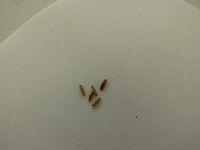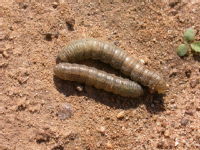All entries for Friday 09 August 2013
August 09, 2013
Carrot fly and hot weather
We would have expected the numbers of carrot fly captured on our traps at Wellesbourne to have increased again by now - to signify the start of the second generation. However, numbers remain low. This may be due to pupal aestivation because soil temperatures have been high for some time.
In some experiments we did many years ago, newly-formed carrot fly pupae were exposed to temperatures of 22-30oC for various 5-10 day periods during pupal development. Exposure to temperatures of 24oC and 26oC caused some, and exposure to 28oC and 30oC caused all, of the pupae to delay development. Development was resumend when the temperature was lowered. Pupae were sensitive to high temperatures only for approximately 4-10 days after pupation.
Carrot fly eggs/newly-hatched larvae are also susceptible to hot/dry conditions and mortality is increased. We do not know how much irrigation would reduce the effects of hot weather.
Carrot fly pupae
Cutworms
It seems that first generation turnip moths (cutworms) have now stopped flying at Wellesbourne. We captured male moths in pheromone traps between 13th June and 25th July - and this is at least 2 weeks later than 'normal'. It appears, therefore, that no more first generation eggs will be laid. However, there is still a risk from the larvae of eggs laid earlier on, and the cutworm forecast will continue to be updated until all these larvae are predicted to have reached the third instar, which will be towards the end of August.
Although it has been hot for several weeks, according to the cutworm model, the sporadic bursts of rainfall have reduced the risk of damage. However, in some locations there may have been insufficent rainfall to completely reduce the risk from batches of eggs that hatched in late June-early July and it would be interesting to hear whether there have been any incidents of cutworm damage?
Update from Wellesbourne
Yesterday we found:
- 12 carrot flies (3 traps) - so still no increase in numbers to signal the start of the second generation. Pupal aestivation......?
- 6 cabbage root fly eggs on 15 plants (second generation appears to be over)
- No silver Y moths - but they are definitely around in quite high numbers at present as we are catching them in a light trap locally
- 15 bean seed flies, 33 pollen beetles, 6 flea beetles (3 traps)
- Butterfly numbers have increased - 19 small white and 9 large white in 3 traps
- 3 diamond-back moth in 3 traps - and reports of activity elsewhere in the country

 Rosemary Collier
Rosemary Collier

 Please wait - comments are loading
Please wait - comments are loading

 Loading…
Loading…

